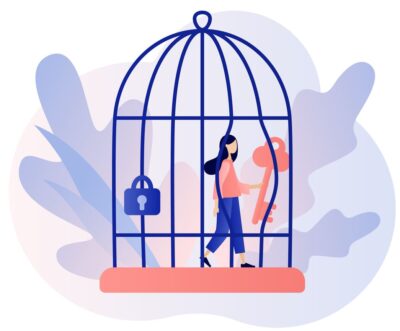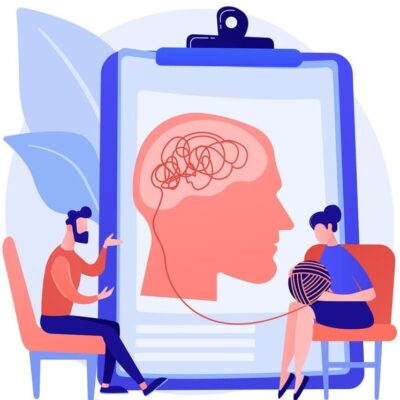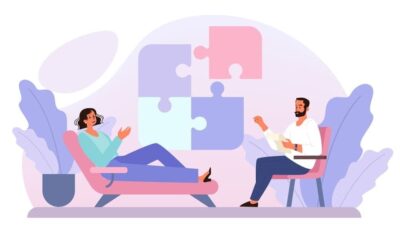Anxiety is a normal response of the organism to stress that has allowed us to survive as a species in situations of danger. It has an adaptive function.
We speak of an anxiety disorder when said reaction occurs in situations that are not dangerous, is excessive due to its intensity or duration, and negatively interferes with our daily lives.
Anxiety can manifest itself through physical symptoms such as sweating, palpitations, tachycardia, dizziness, tremors, a feeling of shortness of breath, cold skin… and psychological symptoms such as a feeling of fear and threat, that something bad is going to happen, inability to relax, irritability, inability to fall asleep, to concentrate or remember things…
There are many types of anxiety disorders, although the main ones are:
Generalized anxiety disorder
Excessive or disproportionate anxiety and worry about routine life events or activities, such as work, being late for an appointment, household chores, the health of oneself or of one’s family…
These concerns are difficult to control, invade thinking, and interfere with attention to immediate day-to-day activities.
In addition, several of the following symptoms are associated: nervousness, fatigue, muscle tension, irritability, problems concentrating, going blank, or sleep problems.

Specific phobias
It is one of the most frequent anxiety disorders.
It consists of intense and disproportionate fear or anxiety for a specific object or situation (eg, flying, heights, spiders, seeing blood…).
The object or situation is avoided, and can be very limiting depending on the case.
Cognitive behavioral therapy has proven to be very effective in treating phobias.

Selective mutism
It is the inability to speak in certain social situations despite the fact that the person speaks without problems in other settings such as at home or with close relatives.
It is usually associated with high social anxiety (excessive shyness, fear of social humiliation, social isolation…), and has negative consequences on academic and work achievements, or on social relationships.
Panic disorder
Sudden and recurring episodes of very intense anxiety (panic) occur, which are not limited to any particular situation and are therefore unpredictable.
Symptoms appear such as a feeling of not being able to breathe, chest pain, a feeling of imminent death, tingling or numbness of the lips or extremities, etc.
It generates fear of suffering another attack in the future or its consequences (fear of dying, of “going crazy”…).
People who suffer from it tend to change their behavior, which often involves avoiding situations that they believe may trigger another episode.
Without treatment it can become very limiting.

Agoraphobia
It is intense fear or anxiety in situations such as leaving the house alone, using public transport, being in closed spaces (supermarkets, cinemas…), or open spaces (parking lots, bridges), or in places where there are a lot of people (a concert…).
These situations generate fear out of proportion to the idea that escaping from a dangerous situation or receiving help if needed could be difficult.
It is a very limiting phobia, so that those who suffer from it avoid these situations or places or always need to be accompanied.
Social anxiety
(social phobia)
There is intense fear or anxiety about social situations in which one can be analyzed by others, such as a meeting.
It consists of a fear of being evaluated negatively, of being thought to be stupid, weak, and of showing symptoms of that nervousness (sweating, trembling, blushing…).
In short, a fear of failure and rejection.
Thus, the person avoids social situations, because they cause intense and disproportionate discomfort.
Separation anxiety
Whoever suffers from it presents excessive anguish before being away from home or from the people to whom it is linked (eg, parents). In early childhood from 1 to 3 years this is normal.
Although there is no exact age at which it can be said that this anxiety is normal, as it varies according to culture and level of development, it typically appears at 7-9 years of age.
They are children who refuse to be alone, may insist that someone stay with them until they fall asleep, or may move into their parents’ bed. They are reluctant to sleep at a friend’s house, or go camping, and may even report physical symptoms such as a stomach ache, a headache… when the separation occurs or is anticipated.
Other anxiety disorders
Anxiety can also be caused by drugs (cocaine, amphetamines, cannabis…), medications (bronchodilators, anticholinergics…) or even by medical conditions (hyperthyroidism, pheochromocytoma, hypoglycemia…).
Anxiety symptoms may also occur without meeting criteria for other specific anxiety disorders.

